The dinner table has become a battleground in many Australian households. Parents face the daunting challenge of satisfying picky eaters whilst ensuring their children receive adequate nutrition during critical developmental years. Meanwhile, concerning statistics reveal that 26.4% of Australian children aged 2-17 years are living with overweight or obesity, with only 4.6% meeting national guidelines for vegetable intake. The solution isn’t restrictive dieting or complicated meal plans – it’s about establishing sustainable, nutritious eating patterns that benefit every family member.
Why Do Family Meals Matter for Children’s Health?
Research demonstrates that family meals provide far-reaching benefits extending beyond basic nutrition. Children who participate in regular family meals tend to consume more fruits and vegetables while reducing their intake of saturated fats and sugar-sweetened beverages. They are less likely to develop obesity and often perform better academically. Moreover, parents benefit from lower stress levels and improved self-esteem, thanks to the positive environment that shared mealtimes create.
What Are Australia’s Recommended Daily Serves for Children?
Australian dietary guidelines outline five essential food groups: vegetables and legumes, fruits, grain foods, lean proteins, and dairy or alternatives. This framework allows parents to construct balanced meals without excessive guesswork.
Daily Serving Requirements by Age Group
| Age Range | Vegetables & Legumes | Fruit | Grain Foods | Protein Foods | Dairy/Alternatives | Water Daily |
|---|---|---|---|---|---|---|
| 2-3 years | 2.5 serves | 1 serve | 4 serves | 1 serve | 1.5 serves | 4 cups (1L) |
| 4-8 years | 4.5 serves | 1.5 serves | 4 serves | 1.5 serves | 1.5-2 serves | 5 cups (1.2L) |
| 9-11 years | 5 serves | 2 serves | 4-5 serves | 2.5 serves | 2.5-3 serves | 5-6 cups (1.4-1.6L) |
| 12-13 years | 5-5.5 serves | 2 serves | 5-6 serves | 2.5 serves | 3.5 serves | 6-7 cups (1.6-1.8L) |
| 14-18 years | 5-5.5 serves | 2 serves | 6-7 serves | 2.5 serves | 3.5 serves | 7-8 cups (1.8-2L) |
Standard serving sizes make meal planning straightforward: a vegetable serve might be ½ cup cooked or 1 cup raw, a fruit serve equates to one medium piece or 1 cup diced fruit, while grain, protein, and dairy serves have similarly clear guidelines.
How Can Parents Successfully Introduce New Healthy Foods?
Children often require 8-15 exposures to a new food before accepting it as part of their diet. A low-pressure environment where the food is simply presented, rather than forced upon the child, can greatly increase acceptance. Combining unfamiliar foods with familiar favorites and allowing children to help in food preparation can also encourage positive responses.
What Nutritional Concerns Affect Australian Children Most?
Several nutritional issues are of concern. Iron deficiency is common, leading to symptoms like tiredness and poor concentration, while inadequate calcium and vitamin D can affect bone health during crucial growth periods. Additionally, a low intake of fruits and vegetables and high consumption of sugar-sweetened beverages and discretionary foods pose significant challenges to optimal nutrition.
How Can Families Implement Practical Meal Planning Strategies?
Practical meal planning can start with small changes such as scheduling 1-2 family dinners per week. Batch cooking, using frozen or seasonal vegetables, and incorporating one-pan recipes can ease the time and cost pressures. Involving children in meal preparation not only lightens the workload but also helps build positive food relationships and practical cooking skills.
Understanding Drinks and Discretionary Foods
Choosing the right beverages is key for children’s nutrition. Water should be the primary drink, supported by milk or fortified alternatives for essential nutrients like calcium and vitamin D. While pure fruit juice may offer some benefits, it should be limited and diluted, and sugar-sweetened beverages should be avoided. Similarly, discretionary foods such as sweets and fried items should be reserved for infrequent treats rather than daily consumption.
Building Sustainable Family Nutrition Patterns
Sustainable nutrition is built over time. Creating a positive mealtime environment—free from screens and filled with meaningful conversation—helps reinforce healthy eating habits. Gradual changes, such as slowly introducing new foods and modifying existing habits, can lead to enduring improvements in family health.
Taking Action for Family Health
Establishing healthy, kid-friendly meals is an investment in the future. Consistency, patience, and celebration of small successes are crucial. By gradually incorporating nutritious options and involving the entire family in the process, parents can lay the foundation for lifelong health benefits, including improved academic performance, better mental health, and reduced chronic disease risk.
How much should I worry if my child refuses vegetables at most meals?
Vegetable refusal is often a normal part of development. Continue to offer small portions without pressure, vary preparation methods, and if concerns about growth or nutritional adequacy persist, consider consulting a healthcare professional.
Can plant-based diets provide adequate nutrition for growing children?
Yes, with careful planning. Ensure key nutrients such as vitamin B12, iron, zinc, calcium, vitamin D, and iodine are included, potentially through fortified foods or supplements. Consulting an Accredited Practising Dietitian can help tailor a balanced plant-based diet.
How many family meals weekly actually make a difference?
Research suggests that starting at around three family meals per week can offer benefits, with further improvements observed when families share up to seven meals weekly. Both the frequency and the quality of the interactions are important.
Should I prepare separate meals if my children won’t eat what I cook?
It is generally recommended to serve family-style meals that include at least one item everyone accepts. This approach encourages children to try new foods gradually rather than reinforcing picky eating through entirely separate meals.
What should I do if my family’s current eating patterns are far from these recommendations?
Begin with small, achievable modifications—such as adding an extra vegetable serving or one additional family meal per week—and gradually build on these changes. Celebrating small successes and seeking advice from an Accredited Practising Dietitian can also help.



